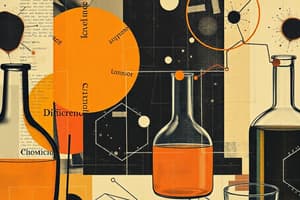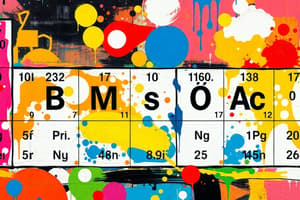Podcast
Questions and Answers
Which of the following statements accurately describes the fundamental difference between a compound and a mixture of elements?
Which of the following statements accurately describes the fundamental difference between a compound and a mixture of elements?
- A compound involves only two elements, while mixtures can contain any number of elements.
- Compounds can only be created in a laboratory, unlike mixtures which can form naturally.
- Mixtures always have properties that are an average of their constituent elements, while compounds exhibit entirely new properties.
- A compound consists of elements that are chemically bonded together, whereas a mixture involves elements that are physically combined but not chemically bonded. (correct)
In the experiment described with iron and sulfur, what observation demonstrates that iron sulfide is a compound and not simply a mixture?
In the experiment described with iron and sulfur, what observation demonstrates that iron sulfide is a compound and not simply a mixture?
- The iron sulfide has a weak attraction to a magnet.
- The iron sulfide visually resembles a mixture of iron and sulfur.
- The iron and sulfur can be easily separated using physical methods.
- The iron and sulfur cannot be physically separated once they have reacted to form iron sulfide. (correct)
Considering the properties of elements and compounds, if you have element X which is a gas at room temperature and element Y which is a solid at room temperature, what can you predict about the properties of the compound XY formed by these elements?
Considering the properties of elements and compounds, if you have element X which is a gas at room temperature and element Y which is a solid at room temperature, what can you predict about the properties of the compound XY formed by these elements?
- The compound XY will exhibit the properties of whichever element is present in greater quantity.
- The compound XY will possess entirely new and different properties compared to elements X and Y. (correct)
- The compound XY will always be a liquid at room temperature, as it is a product of a gas and a solid.
- The properties of the compound XY will be an average of the properties of element X and element Y.
Given the rule for naming simple compounds, and knowing that potassium (K) and oxygen (O) can form a compound, what is the most likely name for the compound formed when these two elements combine?
Given the rule for naming simple compounds, and knowing that potassium (K) and oxygen (O) can form a compound, what is the most likely name for the compound formed when these two elements combine?
Imagine a scenario where you mix zinc powder and iodine crystals in a test tube. Initially, the mixture retains the distinct properties of both zinc and iodine. What action would most likely result in the formation of a compound?
Imagine a scenario where you mix zinc powder and iodine crystals in a test tube. Initially, the mixture retains the distinct properties of both zinc and iodine. What action would most likely result in the formation of a compound?
Flashcards
Molecule
Molecule
Formed when two or more atoms join together via chemical bonds.
Compound
Compound
A substance made of two or more different elements chemically bonded.
Chemical Reaction
Chemical Reaction
A process where chemicals combine or split to form new substances.
Products (of a reaction)
Products (of a reaction)
Signup and view all the flashcards
Sodium Chloride (NaCl)
Sodium Chloride (NaCl)
Signup and view all the flashcards
Study Notes
- Throw elements together for compounds or mixtures.
Compounds Contain Two or More Elements Joined Up
- Molecules form when two or more atoms join via chemical bonds
- Compounds form when atoms of different elements join, e.g., carbon dioxide (CO₂)
- Millions of compounds can be made from elements in the periodic table.
Elements
- Elements are made up of atoms or molecules
- If atoms are the same and not joined, it is an element.
- If atoms are joined, but only one type, it's still an element, e.g., O₂.
Compounds
- Compounds are made up of molecules
- Compounds form when different atoms join together.
- Mixtures can contain compounds e.g., sugar solution (sugar and water).
All Compounds
- All compounds have a formula.
- Formulas include subscript numbers and more than one atom present.
- E.g. the formula for water is H₂O.
- Elements make up compounds.
Naming Compounds
- Sodium and chlorine create sodium chloride (NaCl).
Compounds Have Different Properties to Their Elements
- Chemicals combine or split in reactions to form new substances.
- Reactants: chemicals present at the start of the reaction.
- Products: chemicals at the end of the reaction.
- New compounds synthesized from elements.
- New compounds from reactions have different properties from original elements.
Practical Example: Iron and Sulfur
- Iron reacting with sulfur is a classic example.
- Iron is magnetic, but iron sulfide is not.
Practical Investigation
- Take a test tube with iron powder and sulfur mixture.
- Holding a magnet to the side separates the iron powder.
- Iron moves towards the magnet because it is magnetic while sulfur does not.
- Heat the iron powder and sulfur mixture to create iron sulfide.
- Holding a magnet to the side will not attract the iron sulfide.
- Iron and sulfur are chemically bonded, resisting separation by the magnet.
- The weak attraction may occur if some iron hasn't reacted and remains trapped inside the iron sulfide.
Studying That Suits You
Use AI to generate personalized quizzes and flashcards to suit your learning preferences.





